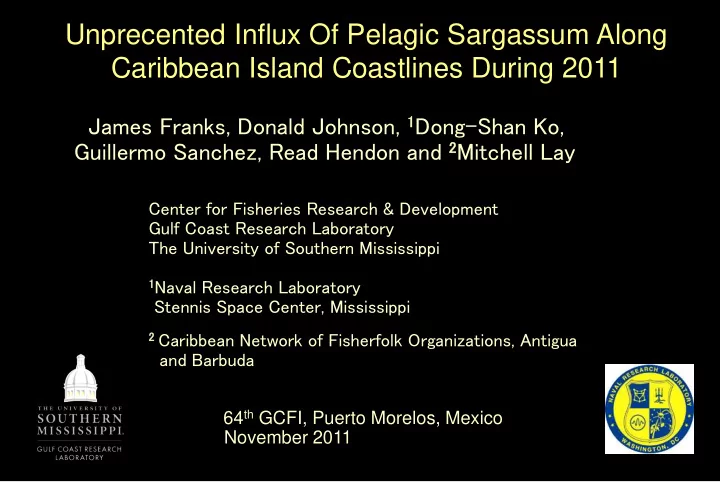

Unprecented Influx Of Pelagic Sargassum Along Caribbean Island Coastlines During 2011 James Franks, Donald Johnson, 1 Dong-Shan Ko, Guillermo Sanchez, Read Hendon and 2 Mitchell Lay Center for Fisheries Research & Development Gulf Coast Research Laboratory The University of Southern Mississippi 1 Naval Research Laboratory Stennis Space Center, Mississippi 2 Caribbean Network of Fisherfolk Organizations, Antigua 2 and Barbuda 64 th GCFI, Puerto Morelos, Mexico November 2011
Pelagic Sargassum - ‘Gulf weed’ Pelagic Brown Alga Class Phaeophyceae Drift alga Two holopelagic species, co-occur Occur in warm waters of Atlantic Ocean Asexual reproduction - fragmentation
Sargassum fluitans Sargassum natans
Dynamic ecosystem Essential Fish Habitat Diverse assemblage of marine life
GRENADA Photo credit: Richard Roach BARBADOS Crane Beach Photo credit: Hazel Oxenford
GUADELOUPE Porte de Désirade Porte d’Enfer – Anse-Bertrand All photos by Franck Mazéas, Responsable Unite biodiversité marine AMP / IFRECOR, Basse Terre
ANTIGUA Mamora Bay Eastern Shore Eli Fuller – Adventure Antigua Photo credit: Max Freeling; Bugpilot
ST. MARTIN , Grandaes Cayes Photo credit: Ouanalao Studios ST. BARTS ST. KITTS , North Frigate Bay Photo credit
Dominican Republic Playa Bavaro Playa de Juancho Photo credit:
Expressed Concerns and Reported Impacts Fisher livelihoods • Entangled lines and nets • Difficulties accessing fishery resources • Vessels: motor intakes (over-heating); launching issues Reefs, benthic communities & seagrasses • Reduced light levels, smothering, decomposition of Sargassum Mangroves; turtles (hatchlings) Power plant cooling water intakes; local infrastructure Tourism: incessant incursion of Sargassum into bays & onto shorelines; decomposition & consequences for local communities
RESPONSE Communications: media reports, videos, interviews, websites, GCFI listserv Aerial surveys – government agencies: assess extent & duration Resource assessments underway in some impacted areas • Biological & socio-economic Information exchange within fishing organizations & co-ops Mobilization of local communities/actions groups • Shoreline cleanups: Antigua & Barbuda Fisherman ’ s Coop.
QUESTIONS “W hy the massive influx of Sargassum” ? • Source/origin of the Sargassum ? • Transport pathway(s) into the region? • Changing/shifting currents regionally? • Local or regional productivity/nutrification event ? • Climate change – warming waters & accelerated growth ? • Duration: singular, annual or episodic event ?
Intra-Americas Sea Ocean Nowcast/Forecast System Naval Research Laboratory, Stennis Space Center, MS USA Real-time operational numerical model: date & location of reported Sagassum coupled w/ current data to back-track movements/distribution of Sargassum through archived currents; predict drift pathways to region May – August 2011
Google Earth Sierra Leone: August 2011 500 km coastline affected by Sargassum Per: Andrew Huckbody; Huckbody Environmental Ltd.
Summary thoughts Summary Thoughts…. Connectivity across the tropical Atlantic via currents Transport pathway(s) into Caribbean region • The local situation probably owes its existence to variation in meterological and oceanographic conditions. Recurrence of 2011 event? • Monitor pelagic Sargassum in the region via combination of satellite imagery & ocean modeling • The ability to monitor pelagic Sargassum in Atlantic Ocean might serve as a predictor of climate change.
ACKNOWLEDGMENTS GCFI Network [GCFINET@LISTSERV.GCFI.ORG] Franck Maz é as (DEAL, Guadeloupe) Hazel Oxenford (Univ. West Indies, Barbados) Issac Croften (Fisheries Division, Ministry of Agriculture, Grenada) Mitch Roffer (Roffer’s Ocean Fishing Forecasting Service, Inc.) Jeannette Mateo (CODOPESCA) Rosemarie Kishore (Institute of Marine Affairs, Trinidad & Tobago) Susan Singh-Renton (CRFM, St. Vincent & The Grenadines) David Olsen (St. Thomas Fisherman ’ s Assoc.) Capt. Anderson Kinch (Barbados) Capt. Marcos Hanke (Puerto Rico) Eugino Pinerio (Puerto Rico) Fadilah Ali (Tobago) Eli Fuller (Adventure Antigua) Andrew Huckbody (Huckbody Environmental Ltd.) Jacques Denis (Martinique) Jim Gower (IOS, Fisheries and Oceans Canada) Photos: R. Roach, Ouanalao Studios, K. Orchard, M. Freeling, O. Reynoso
Recommend
More recommend